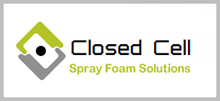WDQ system 14 is an innovation in roofing
Closed Cell Spray Foam Solutions
WDG system 14 has many advantages over conventional roofing. It is also good for the environment, made from recycled and renewable produce, it's 100% sustainable, and the production process involves very little energy use. For volume to coverage rates it requires less transport than any other system available, and in most cases it requires no tear off of the old system, saving on landfill and again on transport. Another benefit is the application of system 14, which involves no heavy equipment or heat sources of any kind. The whole system is simply applied through lengths of hose from the ground, and because the system is so lightweight there is no structural renovation required to create areas of positive drainage or to deal with the problems of ponding. You simply build up an area with the lightweight foam and encourage the water to move in the direction you want it to move. For roof covers which contain aggregate, when removed, the aggregate will weigh more than the SPF system replacing it, this lowers the stress on the roof deck which adds to the life span of the building structure, in fact not only is the weight reduction an issue, the structural capabilities of SPF also adds to the life cycle of a building, the system adheres to the entire surface, with a tensile strength of 75 psi and a compressive strength of 40 psi, it becomes part of the structure rather than just sitting on it.

The nature of the application process means there is no downtime for a facility, this is good news for building owner/occupiers, as down time can be more costly than the initial roofing contract. The foam is applied in liquid form, then expanding quickly, it fills and adheres to every hole and void to form a seamless monolithic finish, it becomes the most complete air barrier system available, wherever the foam is applied it eliminates thermal bridging, air movement and noise,. It also has the best aged value of any insulating material available.
WDG system 14 is also fire rated. It complies with UL 790 and ASTM E-l 80 class A, this makes it one of the safest roofing systems available in both it's application and function. Warranties range from 20 to 30 years, but with a maintenance program in place, these warranties can be extended indefinitely, all that's required is the Silicone to be recoated at the end of the warrantee period and the original warrantee starts again. This is a far more cost effective method than re-roofing a building at the end of it's useful life expectancy. SPF roofs are easy to maintain and repair, any damage to the system is localised, this is because water cannot move latterly through the system, so it's easy to locate, small areas are simply caulked with Silicone and repaired. Larger areas may require the damage to be cut out and re-foamed, none of which affects the warrantee. An in house life cycle cost analysis conducted at Texas A&M University found that the average payback of an SPF system to be less than 5 years through energy savings. In the last 22 years Texas A&M have installed over 8.5 million sqf of SPF roofing on a all of their buildings, they also reduced their maintenance crew from 37 down to 3. Texas instruments also conducted a survey on 20 of their roofs, covering over 3 million sqf, and reported not a single incidence of leakage. Ford Motor Company are the same. Many studies in the US and Canada have been conducted on the cost effectiveness and performance of an SPF roofing system, many of the systems tested are exposed to some of the most extreme weather conditions mother nature has to offer.
Here in Ireland most roofing systems are looked at as a cost which keeps the weather out, we accept the fact that at some stage the system will fail, then we repair them, in doing so we try to prolong the life of the system instead of viewing it as a sign that the system is coming to the end of it's life, then finally when it can be repaired no more we replace it with a similar system, hoping to get another 15 years without any problems, and some systems cannot be insured for more than 10 years even if they are maintained. With prices for energy and petroleum products set to rise constantly over the coming years it means this cycle will only get more expensive in the future. Carbon tax will also be introduced at some stage, so to save on energy costs and tax, insulated roofing systems will be the systems of choice. SPF roofing has the advantage of turning a roofing project into an investment not a cost, over the life cycle of a building there is no system available to compete with it on overall value and performance
Put simply, it is quicker to install, better and cheaper, with an unlimited life expectancy while being environmentally friendly at the same time. Old Asbestos roofs can be rejuvenated with a system that insulates and encapsulates the old roof from the outside for far less than the cost of removal and replacing it with a new system.

All applicators of an SPF roofing system must be registered with the manufacture of the system. They undergo a training and certification program, a contractor should have no problem in producing this certificate on request, a simple phone call to the manufacturer (which we highly recommend) will confirm the contractors credentials, then a contract specification is sent to the manufacturer for their approval before the contract can begin. This is provided in writing and sent back to the client. This is the warrantee, agents for the systems cannot offer these warranties unless the contractor is registered with the manufacturer, this helps to insure that only qualified craftsmen are engaged to apply an SPF system, and it complies with the specification from the manufacturer, this helps to avoid issues with building insurance and warranties at a later stage.

The nature of the application process means there is no downtime for a facility, this is good news for building owner/occupiers, as down time can be more costly than the initial roofing contract. The foam is applied in liquid form, then expanding quickly, it fills and adheres to every hole and void to form a seamless monolithic finish, it becomes the most complete air barrier system available, wherever the foam is applied it eliminates thermal bridging, air movement and noise,. It also has the best aged value of any insulating material available.
WDG system 14 is also fire rated. It complies with UL 790 and ASTM E-l 80 class A, this makes it one of the safest roofing systems available in both it's application and function. Warranties range from 20 to 30 years, but with a maintenance program in place, these warranties can be extended indefinitely, all that's required is the Silicone to be recoated at the end of the warrantee period and the original warrantee starts again. This is a far more cost effective method than re-roofing a building at the end of it's useful life expectancy. SPF roofs are easy to maintain and repair, any damage to the system is localised, this is because water cannot move latterly through the system, so it's easy to locate, small areas are simply caulked with Silicone and repaired. Larger areas may require the damage to be cut out and re-foamed, none of which affects the warrantee. An in house life cycle cost analysis conducted at Texas A&M University found that the average payback of an SPF system to be less than 5 years through energy savings. In the last 22 years Texas A&M have installed over 8.5 million sqf of SPF roofing on a all of their buildings, they also reduced their maintenance crew from 37 down to 3. Texas instruments also conducted a survey on 20 of their roofs, covering over 3 million sqf, and reported not a single incidence of leakage. Ford Motor Company are the same. Many studies in the US and Canada have been conducted on the cost effectiveness and performance of an SPF roofing system, many of the systems tested are exposed to some of the most extreme weather conditions mother nature has to offer.
Here in Ireland most roofing systems are looked at as a cost which keeps the weather out, we accept the fact that at some stage the system will fail, then we repair them, in doing so we try to prolong the life of the system instead of viewing it as a sign that the system is coming to the end of it's life, then finally when it can be repaired no more we replace it with a similar system, hoping to get another 15 years without any problems, and some systems cannot be insured for more than 10 years even if they are maintained. With prices for energy and petroleum products set to rise constantly over the coming years it means this cycle will only get more expensive in the future. Carbon tax will also be introduced at some stage, so to save on energy costs and tax, insulated roofing systems will be the systems of choice. SPF roofing has the advantage of turning a roofing project into an investment not a cost, over the life cycle of a building there is no system available to compete with it on overall value and performance
Put simply, it is quicker to install, better and cheaper, with an unlimited life expectancy while being environmentally friendly at the same time. Old Asbestos roofs can be rejuvenated with a system that insulates and encapsulates the old roof from the outside for far less than the cost of removal and replacing it with a new system.

All applicators of an SPF roofing system must be registered with the manufacture of the system. They undergo a training and certification program, a contractor should have no problem in producing this certificate on request, a simple phone call to the manufacturer (which we highly recommend) will confirm the contractors credentials, then a contract specification is sent to the manufacturer for their approval before the contract can begin. This is provided in writing and sent back to the client. This is the warrantee, agents for the systems cannot offer these warranties unless the contractor is registered with the manufacturer, this helps to insure that only qualified craftsmen are engaged to apply an SPF system, and it complies with the specification from the manufacturer, this helps to avoid issues with building insurance and warranties at a later stage.

Closed Cell Spray Foam Solutions
38 St. Johns Court
Arthane
Dublin 5
Arthane
Dublin 5
 Ireland
Ireland UK
UK Scotland
Scotland London
London










